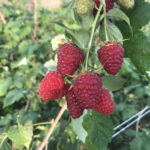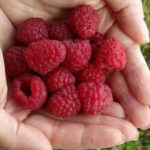Raspberry variety Brusvyana
Brusvyana is a wonderful and very promising variety of remontant raspberries from Ukraine. It was bred in the nursery of the same name, located in the village of Kostovtsy, Brusilovsky district, Zhytomyr region, 75 kilometers from Kiev. The nursery center is a family business of Vladimir Igorevich Dmitriev and his wife, and the owner is not limited to only one management, but also takes an active part in breeding research. With his direct participation in the farm, a number of new varieties of berry crops were born, which successfully passed the test and were officially entered into the State Register of Varieties of Ukraine. One of these author's developments is the heroine of our article, who received state registration in 2008. Vladimir Igorevich began work on its breeding back in 1993, trying to use the Polish raspberry Porana dew (Morning dew) and the best varieties of Russian selection as parental forms. This work was not in vain, and a magnificent hybrid was born, inheriting their best qualities from their parents. In particular, in addition to its remontability, Brusvyana is distinguished by high growth vigor of strong shoots, good heat and frost resistance, disease resistance, large-fruited, high yield, excellent gastronomic and aesthetic characteristics of berries, as well as their good transportability.
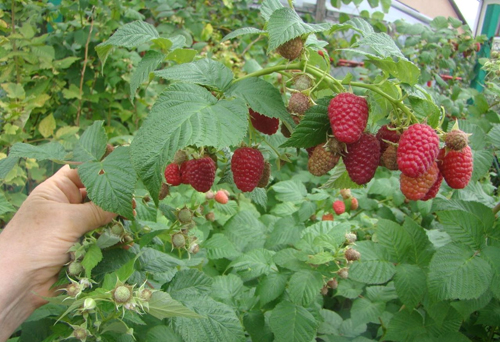
Such a long list of advantages of the new variety could not go unnoticed by gardeners, and in a short time the new product became a bestseller in its homeland. Whole lines of farmers and ordinary amateurs line up at Dmitriev's nursery to purchase elite planting material. Over the past years, our heroine has spread both throughout Ukraine and in Russia, Belarus and a number of other countries. Interest in this raspberry not only does not fade away, but every year it acquires more and more loyal fans.
Agrobiological characteristics
Plants develop very powerful, up to two meters high and stems up to 3-4 cm in diameter. For this feature, Brusvyanu is called almost tree-like, her shoots are so tough. Some gardeners regard this fact as an opportunity to cultivate bushes without arranging trellises, however, owners who have tested the variety on their plots still recommend not to abandon the supports, because the thickness of the stems is a deceptive thing and tall shoots are often unable to withstand strong gusts of wind without a garter. Young shoots are covered with a light layer of waxy bloom, painted in a deep green color, in the second year they turn light brown. The stems are highly branching, and therefore the crown of the bush is often thickened. The internodes are medium. The thorns are weak, the thorns are small, greenish or pale brown, thanks to their rare arrangement, the care of the bushes is greatly facilitated. The leaves are large, very embossed, emerald green, collected from three or five leaves with short petioles. The denticles along the edge of the leaf blade are sharp, saw-shaped, of medium and small size. Falling leaves in the fall begins only after frost. Laterals begin to appear at a height of 50-60 cm from the soil surface, and, thus, the fruit zone is located along the upper 2/3 of the stem. The length of the fruit twigs is moderate; under the weight of the harvest, they do not droop and do not break off. Replacement shoots are formed in significant numbers - in the first year 3-5, and in subsequent years up to 6-8 pieces. The growth activity of the root growth is significant, and therefore the reproduction of raspberries occurs without any problems, but maintaining the raspberry in a neat condition requires certain labor costs.
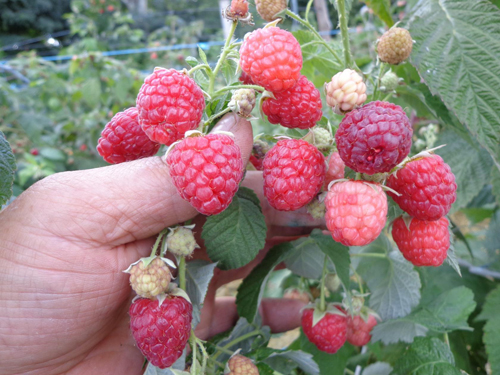
Blossoming of Brusvyana usually occurs in May or June.The flowers are medium in size, painted in pale cream tones, have a very intense pleasant aroma that attracts many insects to the bushes. As a typical remontant variety, our heroine bears fruit in two terms. At the end of June, the berries that have formed on two-year-old shoots begin to ripen, and at the beginning of August comes the turn of the shoots of the current year, from which they harvest until the air temperature drops to negative levels. The berries are collected in rather large brushes, the bushes are literally strewn with them, and therefore harvesting brings only positive emotions. The separation from the stalk is easy, which also makes harvesting easier. But raspberries do not crumble on their own, even when they reach full ripeness. The gross yield from a well-developed bush can be guaranteed to reach 3-4 kg, and many gardeners manage to achieve much higher productivity.
The fruits of our heroine are excellent in appearance, taste and quality. The berries of the first ripening wave are very large, weighing up to 10 grams, their size gradually decreases, and the average weight per season is considered to be 6-8 grams. Their color is bright red, but without the gloss inherent in other varieties. Some breeders consider this fact to be a certain disadvantage, however, the lack of gloss does not exactly affect the gastronomic characteristics. The flesh of raspberries is relatively dense and fleshy, due to which the berry keeps its shape well, and when chewed, its juicy consistency appears. The taste is pleasant and refreshing, sweet and sour with a very fragrant raspberry aroma. In order for the crop to demonstrate its excellent tasting qualities, the bushes need an abundance of sunlight. Plants grown in shade or in regions with few sunny days will produce watery fruits with low sugar accumulation. But in the heat, the berries feel great, they are not baked and do not wither like other varieties.
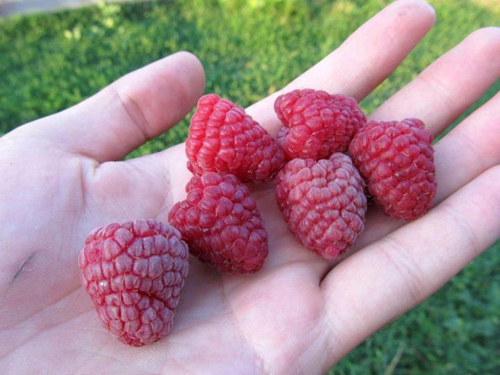
Many fields of application can be found for the harvested Brusvyany. Raspberries are good both for fresh consumption and for canning. Due to their sufficient density, the berries are suitable for long-distance transport, and this fact is especially appreciated by farmers who cultivate the crop for commercial purposes. They also admit that the variety is distinguished by high profitability due to its unpretentiousness, excellent yield and excellent presentation of fruits that never stale on the shelves, arousing increased interest among buyers. Preparations for the winter from our heroine also will not leave anyone indifferent. Delicious, brightly colored and aromatic jams, jams, confiture will not only serve as a wonderful dessert, but also perfectly fill the lack of vitamins in the cold season.
Cultivation of the variety is not at all difficult, and even an inexperienced gardener can handle it. The vast majority of the economic parameters of this raspberry speaks of its excellent resistance to unfavorable environmental factors and the absence of strict requirements for cultivation conditions. The experience of many gardeners cultivating Brusvyana throughout the post-Soviet space also confirms its high plasticity. Of the shortcomings, only average drought resistance and the already mentioned demand for lighting are noted. In winter, under a good snow blanket, the bushes can withstand cold down to -30 ° C and below. Plants are weakly affected by common raspberry diseases, and therefore require only preventive treatments.
Agrotechnical features
The specificity of cultivating the variety is to some extent related to its remontability, otherwise the main activities on the raspberry field do not differ from the traditional ones.
The terrain is of some importance when choosing a site for landing.In the moisture-rich regions of the middle zone, gentle slopes of warm exposures, except for strictly southern ones, are better suited for raspberries. In the latter case, a change in thaws and frosts in winter can provoke damage to plants. In the hot, dry regions of the south, on the contrary, cool slopes are preferred. Well, in any case, one should abandon open heights, from which the wind blows off the snow cover in the cold season, as well as closed basins, where stagnation of cold air is noted. Brusvyana has not revealed any preferences for soil conditions, and therefore it is recommended to exclude during planting only damp, swampy, overly acidic and saline areas, as well as places with a high level of groundwater.
When preparing the soil for a raspberry tree, it must be freed from the most vicious perennial weeds, and also filled with sufficient doses of organic and mineral fertilizers. In household plots, fertilizers can be applied directly to the planting pits, stirring them well with the soil. Raspberries are planted in the fall after leaf fall or in the spring at the first opportunity to go into the field. In the latter case, it is advisable to prepare the pits in advance. Tall bushes also need significant living space, and therefore the distance between the rows is maintained at least 1.5-2 meters, and between plants in a row 0.7-1 meters.
Caring for a fruiting raspberry tree includes keeping row spacings clean, tying the stems to trellises or supports, timely removal of overgrowth and biennial shoots, preventive treatments of raspberries against pests and diseases, and, if necessary and possible, regular watering to maintain optimal soil water balance ... As a remontant variety, Brusvyanu can be completely cut off at the soil level in the fall, getting especially powerful annual shoots the next year, on which only a late summer, but very abundant harvest is formed.




